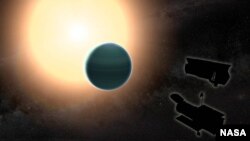An exoplanet located 437 light years away could shed light on the different ways planets form around their stars.
HAT-P-26b, which astronomers call a “warm Neptune,” has a “primitive” atmosphere made almost entirely of hydrogen and helium. Its atmosphere is not cloudy and has a “strong water signature,” astronomers say.
They say the planet, which was first spotted in 2011, is like Neptune and Uranus on mass, but that HAT-P-26b probably formed closer to the star it orbits, or at some point later in the development of the system - or both.
“Astronomers have just begun to investigate the atmospheres of these distant Neptune-mass planets, and almost right away, we found an example that goes against the trend in our solar system,” said Hannah Wakeford, a post-doctoral researcher at NASA’s Goddard Space Flight Center in Greenbelt, Maryland, and lead author of the study published in the May 12, 2017, issue of Science. “This kind of unexpected result is why I really love exploring the atmospheres of alien planets.”
The analysis of HAT-P-26b’s atmosphere was done using both the Spitzer and Hubble space telescopes as the planet transits its star. That allows astronomers to peek into the planet’s atmosphere and analyze the light wavelengths that pass through the planet’s atmosphere.
“To have so much information about a warm Neptune is still rare, so analyzing these data sets simultaneously is an achievement in and of itself,” said co-author Tiffany Kataria of NASA's Jet Propulsion Laboratory in Pasadena, California.
Astronomers were also able to use that data to determine the planet’s metallicity, as a measure of elements heavier than hydrogen and helium in the atmosphere. Metallicity can be used to determine how the planet formed.
For example, Jupiter has a metallicity about two to five times that of our sun. Saturn has about 10 times as much. Astronomers say those planets, referred to as gas giants, are almost entirely composed of hydrogen and helium.
The next two planets out, Neptune and Uranus, which are called ice giants, have metallicities about 100 times that of the sun.
Astronomers say that’s because Neptune and Uranus formed on the colder part of the disk of debris that circled our sun as the planets developed. They were likely bombarded by icy debris rich in heavier elements.
Jupiter and Saturn formed in a warmer part of the disc, meaning they weren’t hit by as many of those objects.
This pattern has been observed on two other exoplanets, HAT-P-11b and WASP-43b.
HAT-P-26b does not follow that pattern because despite being relatively close to its star, it has low metallicity, similar to Jupiter.
“This analysis shows that there is a lot more diversity in the atmospheres of these exoplanets than we were expecting, which is providing insight into how planets can form and evolve differently than in our solar system,” said David Sing of the University of Exeter and the second author of the paper. “I would say that has been a theme in the studies of exoplanets: Researchers keep finding surprising diversity.”








